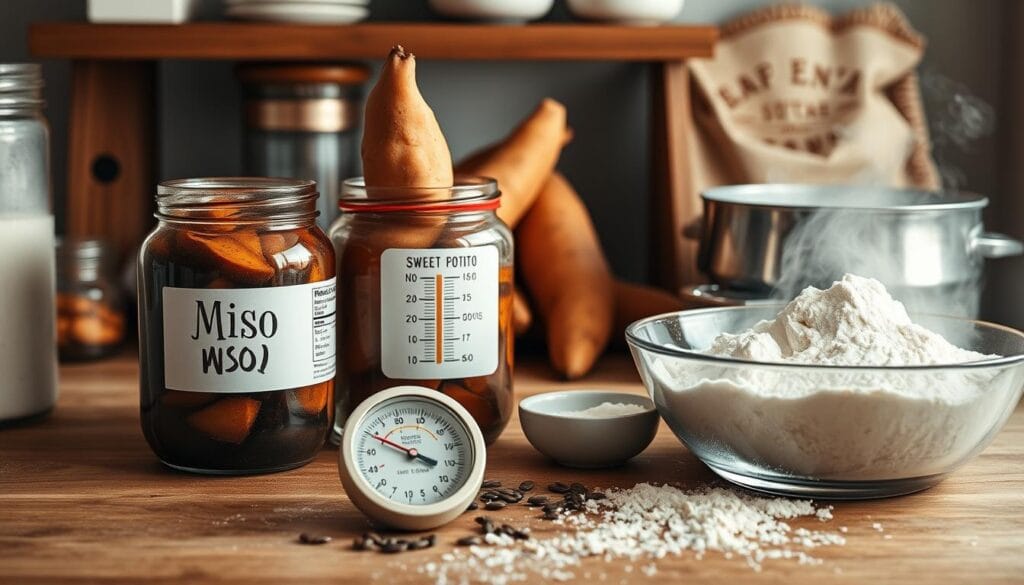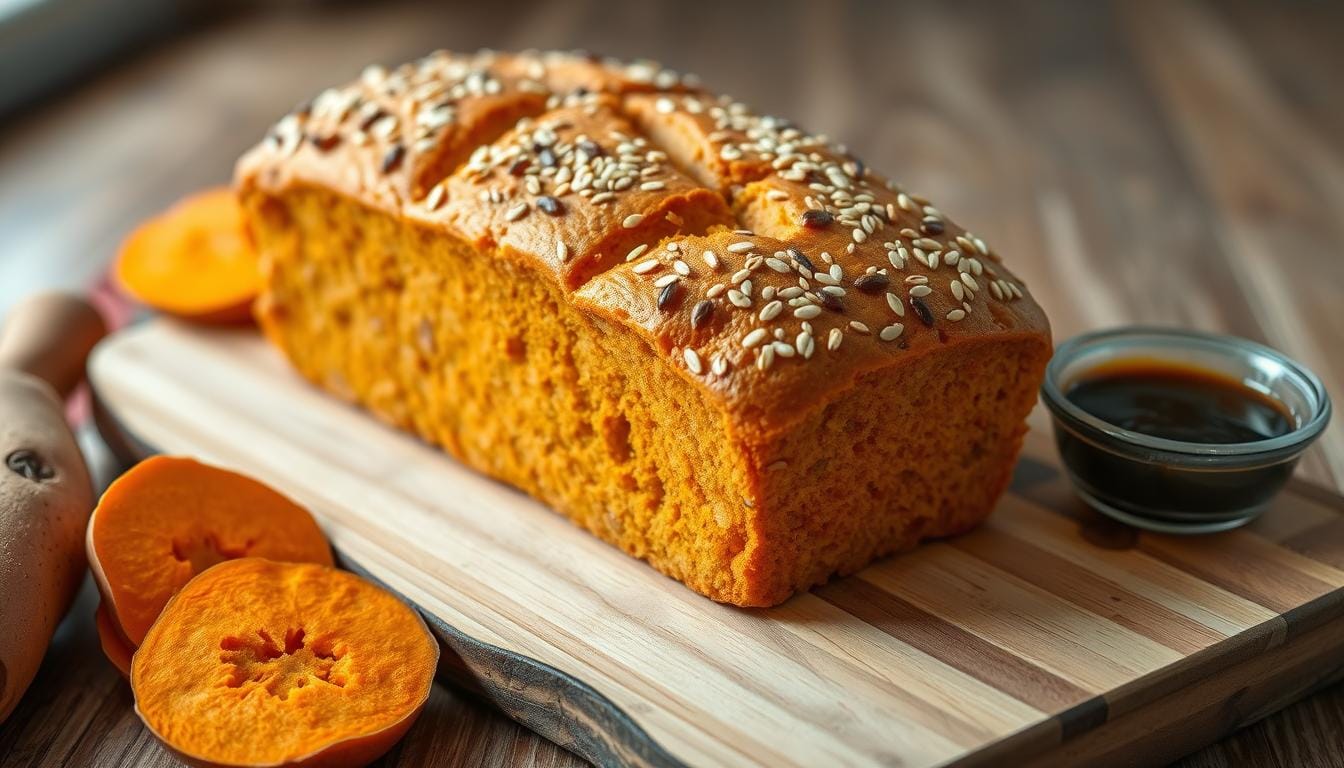Seeded Miso Sweet Potato Bread Recipe: Easy & Tasty
As the sun peeked through the kitchen window, the aroma of freshly baked bread filled the air. It instantly took me back to my grandmother’s cozy kitchen. Baking bread was a ritual that brought our family together, a tradition I’ve kept alive.
Now, I want to share with you a recipe that combines sweet potatoes, miso, and seeds. It’s the Seeded Miso Sweet Potato Bread. This bread has comforting flavors, a satisfying crunch, and is easy to make.
Table of Contents
Introduction
If you want to make your baking better, try this unique flavor combination of seeded miso sweet potato bread. It mixes sweet potatoes’ natural sweetness with miso paste’s savory taste. This creates a perfect balance of flavors that’s both cozy and fancy.
This bread stands out because it has nutrient-rich seeds like sesame, sunflower, pumpkin, flax, and chia. These seeds add a nice crunch and pack the bread with good fats, proteins, and minerals. It’s a versatile choice, great for breakfast or dinner.
If you love baking or want to try something new, this recipe is for you. You’ll enjoy the sweet, savory, and nutty tastes in every bite.
“The mix of sweet potatoes, miso, and various seeds makes a unique and tasty bread that will wow you.”
History and Background
The history of sweet potato bread goes back centuries. It’s deeply rooted in the American South and African-American communities. Sweet potatoes are a staple here, loved for their sweetness and health benefits.
Origins of Sweet Potato Bread
Over time, bakers have added new ingredients to sweet potato bread. Miso paste, a Japanese seasoning, is a recent addition. It brings a savory depth to the bread.
Introduction to Miso in Baking
Miso paste adds a unique twist to baking. It pairs well with sweet potatoes in the seeded miso sweet potato bread. This mix improves the bread’s flavor and makes it moist.
The Fusion Concept in Seeded Miso Sweet Potato Bread
The seeded miso sweet potato bread is a mix of traditions. It combines sweet potatoes’ sweetness with miso’s savory taste. Seeds like sesame and sunflower add crunch and nutrition.
“The fusion of sweet potatoes and miso in this recipe not only enhances the overall flavor but also improves the bread’s texture, making it moist and tender.”
Ingredients Breakdown
The seeded miso sweet potato bread recipe combines wholesome ingredients for a tasty and healthy treat. Let’s explore the main parts that make this bread special:
Primary Ingredients for Seeded Miso Sweet Potato Bread
Sweet potatoes are at the core of this recipe. They add natural sweetness, moisture, and a vibrant purple color. Miso paste brings a deep umami flavor and richness. Whole wheat flour adds a hearty texture and boosts nutrition. Eggs help the bread keep its shape.
Sweeteners like honey or maple syrup add sweetness. Vegetable oil keeps the bread moist and tender.
Seed Topping for Extra Crunch
- Sunflower seeds: A good source of vitamin E and healthy fats, adding a satisfying crunch to the bread’s crust.
- Pumpkin seeds: Loaded with magnesium, zinc, and antioxidants, pumpkin seeds bring a unique nutty flavor and texture.
- Sesame seeds: These tiny seeds not only contribute to the visual appeal but also provide a delightful crunch and nutty taste.
- Flaxseeds: Rich in omega-3 fatty acids, flaxseeds not only enhance the nutritional profile but also help improve the bread’s texture.
These ingredients come together to create a seeded miso sweet potato bread. It’s visually appealing, full of flavor, and nutritious. The mix of sweet potatoes, miso, and seeds makes this recipe a delightful and wholesome treat.
| Ingredient | Nutritional Benefits |
|---|---|
| Sweet Potatoes | Excellent source of beta-carotene (Vitamin A), rich in fiber, and have a lower glycemic index compared to regular potatoes. |
| Miso Paste | Fermented food packed with probiotics that support healthy digestion. Recommended to use white miso for a milder flavor. |
| Whole Wheat Flour | Provides a hearty texture and boosts the nutritional value of the bread. |
| Sunflower Seeds | Good source of vitamin E and healthy fats, bringing a unique crunch to the bread’s crust. |
| Pumpkin Seeds | Loaded with magnesium, zinc, and antioxidants, adding texture and a nutty taste. |
| Sesame Seeds | Contribute to the visual appeal and provide a delightful crunch and nutty flavor. |
| Flaxseeds | Rich in omega-3 fatty acids, beneficial for heart health and improving the bread’s texture. |
Equipment Needed
To bake the delicious seeded miso sweet potato bread, you’ll need some baking essentials and optional tools. These tools can make the baking process smoother. Here’s what you’ll need:
- A 9×5-inch loaf pan: This size is perfect for baking the bread to the right shape and thickness.
- Mixing bowls: You’ll need at least two bowls – one for mixing the wet ingredients and another for the dry.
- Measuring cups and spoons: Accurate measurements are key for consistent results.
- An electric mixer or whisk: This will help you achieve a smooth, well-incorporated batter.
- A spatula: Invaluable for scraping down the sides of the bowls and ensuring even mixing.
- A cooling rack: This will allow the freshly baked bread to cool properly before slicing.
While the above items are the baking essentials, there are a few optional tools that can make the process even easier:
- A food processor: This can be used to quickly and effortlessly mash the sweet potatoes.
- A stand mixer: If you’re baking larger batches, a stand mixer can take the strain out of mixing the dough.
With these baking essentials and optional tools at hand, you’ll be well on your way to creating the perfect seeded miso sweet potato bread.

Step-by-Step Seeded Miso Sweet Potato Bread Recipe
Making Seeded Miso Sweet Potato Bread is easy and rewarding. Follow these steps to make this tasty bread at home:
- Start by baking or steaming sweet potatoes until they’re soft. Mash them and set aside.
- Preheat your oven to 350°F (175°C). Grease a 9×5-inch loaf pan.
- In a big bowl, mix mashed sweet potatoes, miso paste, sweetener, eggs, oil, and vanilla. Mix well.
- In another bowl, whisk together whole wheat flour, baking soda, baking powder, salt, cinnamon, and nutmeg.
- Add the dry ingredients to the wet mixture slowly. Stir until just combined. Don’t overmix.
- Fold in half of the seeds. Save the rest for the topping.
- Put the batter in the loaf pan and smooth the top. Sprinkle the remaining seeds on top.
- Bake for 45-50 minutes. A toothpick inserted in the center should come out clean.
By following this baking process, you’ll make a delicious Seeded Miso Sweet Potato Bread. It’s packed with unique flavors and a great texture.
Baking Tips for Success
To make the perfect seeded miso sweet potato bread, focus on the right ingredient temperatures and sweet potato consistency. These factors are key to a moist, flavorful, and appealing loaf.
Ingredient Temperature for Optimal Mixing
The temperature of your ingredients, especially the sweet potatoes, is crucial. Bake or mash the sweet potatoes to about 400°F (200°C) for 1 to 1.5 hours. This temperature ensures the ingredients mix well, creating a tender crumb.
Achieving Perfect Sweet Potato Consistency
The sweet potato puree’s consistency is also vital. It should be smooth and creamy, not too wet or dry. This consistency makes the bread moist and flavorful, with the sweet potato taste prominent.
| Ingredient | Optimal Temperature |
|---|---|
| Sweet Potatoes | 400°F (200°C) for 1-1.5 hours |
| Miso Paste | Room temperature |
| Flour | Room temperature |
| Yeast | Room temperature |

By following these tips, you’ll bake a delicious and attractive seeded miso sweet potato bread.
Flavor and Texture Enhancements
Adding different ingredients can make your seeded miso sweet potato bread even better. Spices like cinnamon or nutmeg add a warm, cozy taste. Chopped nuts such as walnuts or almonds give a nice crunch. For sweetness, try adding dried fruits or chocolate chips.
Don’t be afraid to try savory herbs like rosemary or thyme for unique flavors. These simple changes can make your bread stand out. You can make it spicy, nutty, or sweet, depending on what you like.
| Add-In | Amount | Effect |
|---|---|---|
| Cinnamon | 1 tsp | Warm, comforting flavor |
| Nutmeg | 1/2 tsp | Spicy, aromatic undertones |
| Walnuts | 1/2 cup, chopped | Crunchy texture |
| Almonds | 1/2 cup, chopped | Nutty, buttery flavor |
| Dried cranberries | 1/4 cup | Chewy, tart sweetness |
| Chocolate chips | 1/3 cup | Rich, indulgent sweetness |
| Rosemary | 1 tbsp, chopped | Savory, earthy notes |
| Thyme | 1 tsp, chopped | Herbaceous, slightly minty flavor |
Don’t be shy to try new ingredients for your perfect seeded miso sweet potato bread. The world of possibilities is vast. So, have fun and let your creativity run wild!
Recipe Variations
The seeded miso sweet potato bread recipe can be easily adapted to suit various dietary preferences and flavor profiles. Whether you’re looking to make a gluten-free version or explore a vegan option, there are plenty of ways to put your own spin on this delicious bread.
Gluten-Free Seeded Miso Sweet Potato Bread
For a gluten-free take on this recipe, you can substitute the whole wheat flour with a gluten-free flour blend. This will ensure the bread is suitable for those following a gluten-free diet, without compromising on the moist and flavorful texture.
Vegan Adaptation for Seeded Miso Sweet Potato Bread
To make the bread vegan, you can use flax or chia eggs in place of regular eggs. These plant-based alternatives will bind the ingredients together, creating a delightful vegan-friendly loaf. You can also experiment with low-sugar sweeteners like dates or coconut sugar to keep the bread mildly sweet.
Beyond these core substitutions, the recipe’s versatility extends to the seed topping. Feel free to play with different seed combinations, such as sesame, poppy, or hemp seeds, to create unique textures and flavors. Additionally, you can explore savory variations by incorporating herbs, spices, or even roasted vegetables into the dough.
No matter which direction you choose to take the seeded miso sweet potato bread, the end result is sure to be a delicious and nourishing addition to your baking repertoire.
Conclusion
The seeded miso sweet potato bread is a tasty mix of sweet potatoes and miso paste. It also has seeds like sunflower and sesame for extra crunch and nutrition. You can enjoy it for breakfast, as a snack, or with meals.
Try this recipe and make it a favorite at home. It’s delicious and easy to make. The seeded miso sweet potato bread is a treat for your taste buds and a healthy choice for baking.
Experience the sweet, savory, and nutty flavors of this bread. Its moist texture and crunchy seed topping are amazing. This recipe proves how sweet potatoes and miso can create something special. Impress your loved ones with this homemade gem.
FAQ
What makes the seeded miso sweet potato bread recipe unique?
What are the key ingredients in the seeded miso sweet potato bread recipe?
What equipment is needed to make the seeded miso sweet potato bread?
How do you achieve the perfect texture for the seeded miso sweet potato bread?
Can the seeded miso sweet potato bread recipe be customized?
Source Links
- Seeded Miso Sweet Potato Bread Recipe: A Flavor-Packed, Nutritious Delight – https://erinrecipes.com/seeded-miso-sweet-potato-bread-recipe/
- Seeded Miso Sweet Potato Bread Recipe – https://www.rollrecipe.com/seeded-miso-sweet-potato-bread/
- Seeded Miso Sweet Potato Bread Recipe 2024: Easy & Tasty – Recipes Suggest – https://recipessuggest.com/seeded-miso-sweet-potato-bread-recipe/
- Best Seeded Miso Sweet Potato Bread Recipe – https://gdrecipes.com/seeded-miso-sweet-potato-bread-recipe/
- Seeded Miso Sweet Potato Bread Recipe – https://yourquickyrecipes.com/seeded-miso-sweet-potato-bread-recipe/
- Seeded Miso Sweet Potato Bread Recipe: Easy & Tasty – https://dishymoments.com/seeded-miso-sweet-potato-bread-recipe/
- Sweet Potato Hummus – https://zenaskitchen.com/sweet-potato-hummus/
- The (R)evolution of Indigenous Foods – https://www.catersource.com/food-beverage/revolution-indigenous-foods
- 5-Step Easy Seeded Miso Sweet Potato Bread Recipe – A Healthy Guide – https://tasteuprecipes.com/seeded-miso-sweet-potato-bread-recipe/
- Miso Tahini Whipped Sweet Potato Bowl with Spiced Beans and Broccolini – https://makeitdairyfree.com/miso-tahini-whipped-sweet-potato-bowl-with-spiced-beans-and-broccolini/
- What to serve with tuna steaks – https://agiletestkitchen.com/purple-sweet-potato-recipes/
- Seeded miso sweet potato bread recipe – CulinarRecipes – https://culinarrecipes.com/seeded-miso-sweet-potato-bread-recipe/
- Miso Glazed Sweet Potatoes – https://thevegan8.com/miso-glazed-sweet-potatoes/
- Anadama Bread – Step by Step, Making Yeast Bread – https://thecreeksidecook.com/anadama-bread-step-by-step-making-yeast-bread/
- Brown rice and sesame sourdough bread recipe | The Perfect Loaf – https://www.theperfectloaf.com/brown-rice-and-sesame-sourdough-bread-recipe/
- African Sweet Potato Peanut Stew – https://eatplant-based.com/african-sweet-potato-peanut-stew/
- Perfectly Baked Okinawan Sweet Potato – https://eatplant-based.com/okinawan-sweet-potato/
- Philadelphia Cheesecake Recipe: Creamy Perfection – https://recipechefoliver.com/philadelphia-cheesecake-recipe/
- Easy Rotel Dip Recipe: Creamy Party Favorite – https://recipechefoliver.com/rotel-dip-recipe/
- Banana Bread Recipe (one-bowl) – https://www.pickuplimes.com/recipe/one-bowl-chocolate-banana-bread-273
- Winter Detox Moroccan Sweet Potato Lentil Soup Recipe | Little Spice Jar – https://littlespicejar.com/moroccan-sweet-potato-lentil-soup/
- Healthy Raw Vegan Bread Recipe – Perfect for Any Meal – https://viedelavegan.com/raw-vegan-bread-recipe/
- Easy Lentil Quinoa Flatbread Recipe (High-Protein) – https://cookingforpeanuts.com/lentil-quinoa-flatbread-recipe/
- Ancient Grain Harvest Bowl with Miso Orange Sauce (Vegan) – Plant Based Jess – https://plantbasedjess.com/ancient-grain-harvest-bowl-with-miso-orange-sauce-vegan/
- 3 Secrets to the Best Seeded Miso Sweet Potato Bread Recipe – https://www.tastetriumph.com/seeded-miso-sweet-potato-bread-recipe/
- Best Hoagie Roll Recipe – https://www.rollrecipe.com/hoagie-roll-recipe/

